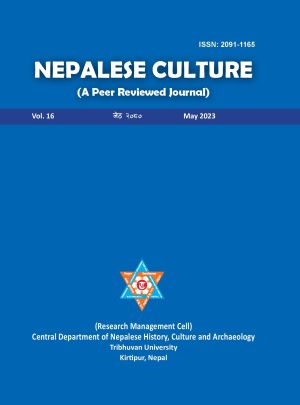गथामग अर्थात् घण्टाकर्णः एक साँस्कृतिक अध्ययन {Cultural Study of Gathamaga or Ghantakarna}
DOI:
https://doi.org/10.3126/nc.v16i1.54162Keywords:
Ghantakarna, Cultural study, Beliefs, RitualsAbstract
नेपालमा बसोबास गर्ने विविध समुदाय मध्येको एक प्रमुख समुदाय ‘नेवार’ समुदाय हो । नेवार समुदाय नेपालको आदिबासी जनजातिमा गणना हुने समुदाय हो, जुन पूर्व मध्यकालदेखि नै व्यापार व्यवसायको सिलसिलामा काठमाडौ उपत्यकाबाहेक पनि नेपालको प्रायः सम्पूर्ण स्थानमा बसाइ सरी आफ्नो अस्तित्व स्थापना गर्न सफल रहँदै आएको छ । तर नेवार समुदाय नेपालभरि फैलिए पनि नेवार समुदायमा मनाउने पर्व तथा चालचलनको अस्तित्व काठामाडौ उपत्यकाका जिल्लाहरुमा मात्र जिवित रहेको देखिन्छ, त्यसमा पनि भक्तपुर नै एक मात्र स्थान रहेको छ, जहाँ नेवार समुदायले प्राचीन तथा मध्यकालदेखि चलाउँदै, मनाउँदै आएका जात्रापर्व, चालचलन एवं संस्कृतिहरु जस्ताको तस्तै तथा समयसापेक्ष परिवर्तन गरी जिवित रहँदै आएको छ । तर आधुनिक विज्ञानको युगमा नयाँ पुस्ताले भने नेवार समुदायको साँस्कृतिक पक्षमा चासो कम राखेको र अग्रज पुस्ताद्धारा साँस्कृतिक ज्ञान पुस्तान्तरण नगरिएका कारण हराउन थालेको भने पक्कै हो । जे जस्तो अवस्था भए पनि वर्तमान समयमा अस्तित्वमा रहेका धार्मिक तथा साँस्कृतिक पक्षलाई मात्रै पनि जोगाई राख्न सकेको खण्डमा आउने भावी पुस्तालाई उपहार स्वरुप प्रदान गर्न सकिन्छ ।
नेवार समुदायलाई धार्मिक रुपले हिन्दु नेवार समुदाय र बौद्ध नेवार समुदाय गरी विभाजित गर्न सकिन्छ, र यी दुबै धर्मावलम्बीहरुको आ–आफ्नै उल्लेखनीय सांस्कृतिक पक्षहरु रहेका छन् । हिन्दु तथा बौद्ध धर्मावलम्बी दुबै समुदायले विना सङ्कोच तथा विना विभेद वर्षभरी आउने जात्रा तथा पर्व भने मनाएका हुन्छन् तर तरिकामा भने फरक हुन सक्छ, जुन धार्मिक सहिष्णुताको अनुपन नमुना हुन् । नेवार समुदायमा मनाउने विभिन्न जात्रा÷पर्वहरुमध्ये गथांमुग जात्रा पनि एक महत्वपूर्ण जात्रा हो । यो दिनलाई नेवार समुदायमा गथांमुगः गथामग गाथामग चःहे, गथामंगल चःहे, घण्टाकर्ण चतुर्दशी जस्ता इत्यादि नामले पनि चिनिने गरिन्छ भने गाउँघरतिर लुटो फाल्ने दिनको रुपमा मनाइने चलन छ । भक्तपुरमा भने नर्कत तथा छ्वालीको त्रिखुट्टे मानव कदको आकृति निर्माण गरी शहरको मूख्य चोक तथा शहर बाहिर लगी जलाइन्छ । घरमा हुने अनिष्ट तथा आउन सक्ने भूतप्रेत, आत्मा तथा नकारात्मक शक्तिलाई नष्ट गर्ने हुने विश्वास गरिन्छ । सोहि दिनमा चोक तथा खोला छेउ वा शहर बाहिर लगेर गथामुगलाई जलाउने गरिन्छ । बच्चाहरूमा रोगव्याधि नआओस्, कुनै नकारात्मक शक्तिले असर नपुर्याओस् र विशेष गरी रुञ्चे रोग नसरोस् भनी बच्चाहरूलाई जलाइएका गथामुगको खरानीबाट आउने धुवाँमा आमा बुबाको साहयताबाट नाघ्न लगाइन्छ । गथामग चःहेलाई सरसफाई गरी मनाउने एक पर्वको रुपमा पनि मान्ने गरिन्छ । किसानहरु असारमा रोपाइंमा अति व्यस्त हुने हुँदा घर–कोठा अव्यवस्थित भई सर–सफाइ खाँचो पर्ने हुन्छ । जसका कारण लामखुट्टे, भुसुना, तथा अन्य हानिकारक परजीवी किराजन्य तत्वले डेरा जमाउने हुँदा यस पर्वको दिन वा अघिल्लो दिनदेखि नै सरसफाइ गरी घरबाट निस्किने सम्पूूर्ण नकारात्मक तत्व फाल्न लगिन्छ ।
{Among the many different groups found in Nepal, the "Newar" community is one of the larger ones. Since the ancient period, the Newar group, are considered as the indigenous group; who have migrated to all parts of the country with the exception of the Kathmandu Valley for commercial purposes. Despite the Newar community's widespread presence in Nepal, it appears that the social and religious celebrations continue in the districts of the Kathmandu Valley, specifically Bhaktapur, since ancient and medieval times, in a way that is appropriate for the period. These celebrations have evolved and been alive. Yet, in the era of contemporary science, the younger generation seem less interested in the cultural facets of the Newar group, and it is undeniable that the loss of cultural knowledge has begun as a result of the elder generations' failure to transmit it. Whatever the circumstances, it would be a gift to future generations to preserve the religious and cultural features that are currently in existence.Among the Newars there are two main religious subgroups comprising of Hindu and Buddhist populations. Both observe festivals and fairs all year long without reservation or prejudice, but they do so in various ways, which is an illustration of religious tolerance. The Gathamug festival is one of many holidays observed by the Newar community,This day is also known as Gatha̅mug, Gatha̅mag, Gathemangal, Ghanta̅karna Chaturdashi, etc. in the Newar community. A three-legged figure constructed of reeds (Narkat) and chhwa̅li is made and burned in Bhaktapur's central square and on the outskirts of the city. This symbolizes of overpowering of the bad spirits, ghosts or a̅tma̅, and negative energy within the home. Gatha̅mag is taken that day to be burned in the chok or streets of the city, river bank, or outside the city as the death ritual. With the assistance of their parents, children are made to bathe in the smoke produced by burning gatha̅maga in order to protect them from infections, harmful influences, and illness.Gatha̅maga Charhe or Ghanta̅karna Chaturdasi is regarded as a festival that is observed through cleaning. the house and rooms the farmers are quite busy in June with rice plantations. Because of this, it is cleaned on the day of the Gatha̅maga festival or the day before, and all the unfavorable things coming out of the home are brought to be thrown away, since mosquitoes, gnats, and other dangerous parasitic insects camp there}.
Downloads
Downloads
Published
How to Cite
Issue
Section
License
© Central Department of Nepalese History, Culture and Archaeology, Tribhuvan University




